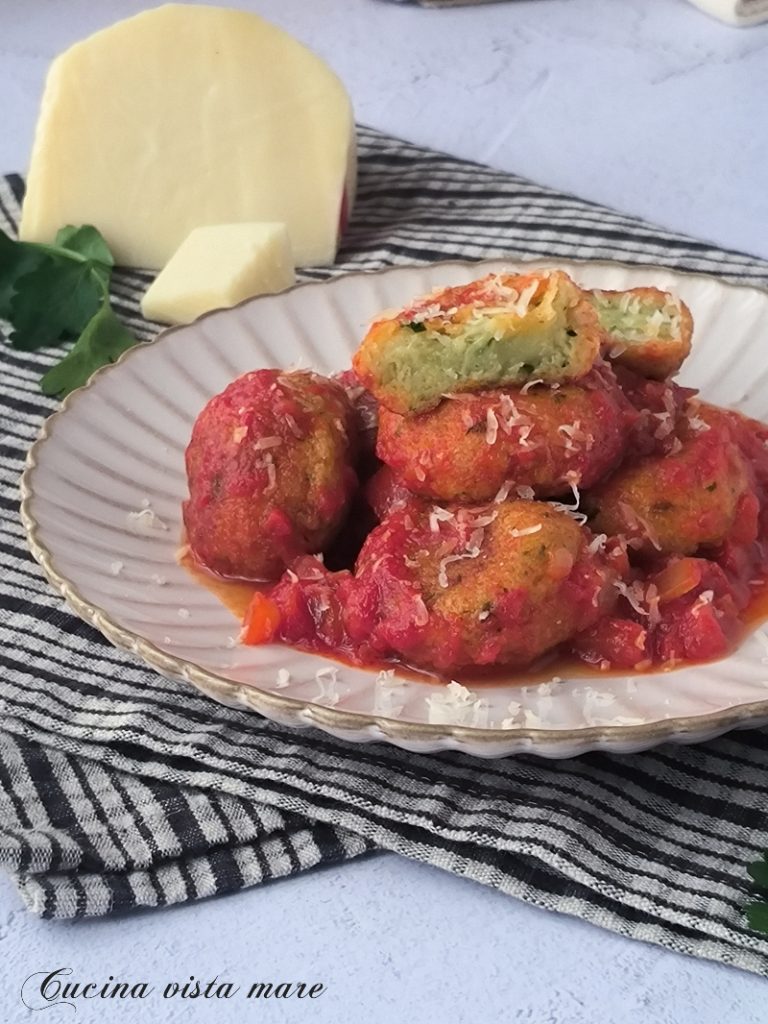Cheese and egg balls are a typical dish of Abruzzese cuisine, a traditional peasant recipe that revolves around local products. It is a substantial dish despite being simple, providing the fuel needed to support workers during long days in the fields. Bread, cheese, and eggs, simple ingredients for an explosion of taste and flavor capable of winning over even the most demanding palates. The cheese and egg balls recipe is my contribution to the “Tasty Abruzzo” column created by my colleagues Mary from “An American Among the Bears” and Francesca from “Spice Powder“. Every month, a nice group of Abruzzese food bloggers, using local ingredients, takes you on a journey to discover excellent but perhaps little-known dishes and ingredients. There’s an open debate about cheese and egg balls. I’ll tell you more at the end of the article. But first, let’s head to the kitchen!
Don’t miss it

- Difficulty: Easy
- Cost: Economical
- Preparation time: 20 Minutes
- Portions: 2 people
- Cooking methods: Stove, Frying
- Cuisine: Regional Italian
- Region: Abruzzo
- Seasonality: Fall, Winter, and Spring
Ingredients
- 1¾ oz stale bread
- to taste milk
- 5¼ oz rigatino cheese (medium-aged)
- 1 egg
- 1 tsp fresh chopped parsley
- 1/2 yellow onion
- 1 oz red pepper
- 10½ oz tomato puree (homemade)
- 1 pinch salt
- to taste peanut oil
Tools
- 1 Cutting board
- 1 Kitchen knife
- 2 Bowls
- 1 Coarse grater
- 1 Low-edge casserole
- 1 Frying pan
- 1 Skimmer
Steps
Cut the stale bread into small cubes and soak it in milk. Grate the rigatino cheese using a coarse grater. In a bowl, work the squeezed bread, cheese, chopped parsley, and egg. Knead until you get a compact loaf. Prepare the balls: take some dough and work it with your hands to form round meatballs, all as similar in size as possible.
Prepare the sauce. Finely slice the onion. Wash the bell pepper and cut it into small cubes. In a low-edge casserole, heat the oil and let the vegetables sauté for a few minutes, then add the tomato puree, preferably homemade: mine is my mom’s. Cook the sauce for ten minutes, then adjust the salt.
In a frying pan, heat the peanut oil and fry the balls until golden. Drain them on absorbent paper and then toss them for a few minutes in the tomato sauce. Serve the cheese and egg balls hot with their sauce, topped with more grated rigatino and, if desired, bread for “scarpetta”: it’s a must here!
Notes
This content contains one or more affiliate links.
Curiosities
Bread yes. Bread no. Fried yes. Fried no. Which cheese? Pecorino? Rigatino? Parmigiano? The recipe changes between towns and even between neighbors. Let me tell you how I see it. My grandmother was born in 1919 in Torricella Sicura, a small town in the province of Teramo. She lived through almost the entire century. On her path, she encountered the war that took her husband away, faced economic hardships, and lived through poverty. Nothing could be wasted. Nothing was thrown away. Often, she couldn’t choose the ingredients. She would open the pantry and make “things” with whatever was there. The bread? As she would say, the balls were often more bread and less of everything else. So yes, if the family was poor, the cheese and egg balls had bread. The same goes for the cheeses. Some use rigatino, some cow’s milk cheese or mixed, some use pecorino, and others say “no, rigatino is not suitable”. Some even use Parmigiano or Grana. The thing is, today in times of prosperity, we are used to choosing, but it wasn’t like that in the past. It is even said that during wartime, to protect bread, eggs, and cheese from looting, people would hide them under the floor or behind bricks. The balls contained whatever was available, and everyone made them their own way. The original recipe? Maybe it exists. Maybe not. Who knows. My recipe? It’s similar yet different from many.
Rigatino cheese and there’s a lot to say here because some say it’s not Abruzzese, some even say it’s foreign. I bought one made with sheep’s milk from an Abruzzese company. I bought it on site. It’s a cream-colored cheese, medium-aged, with a compact texture, clean, and ridged rind. If you can’t find it, you can use a medium-aged pecorino.

